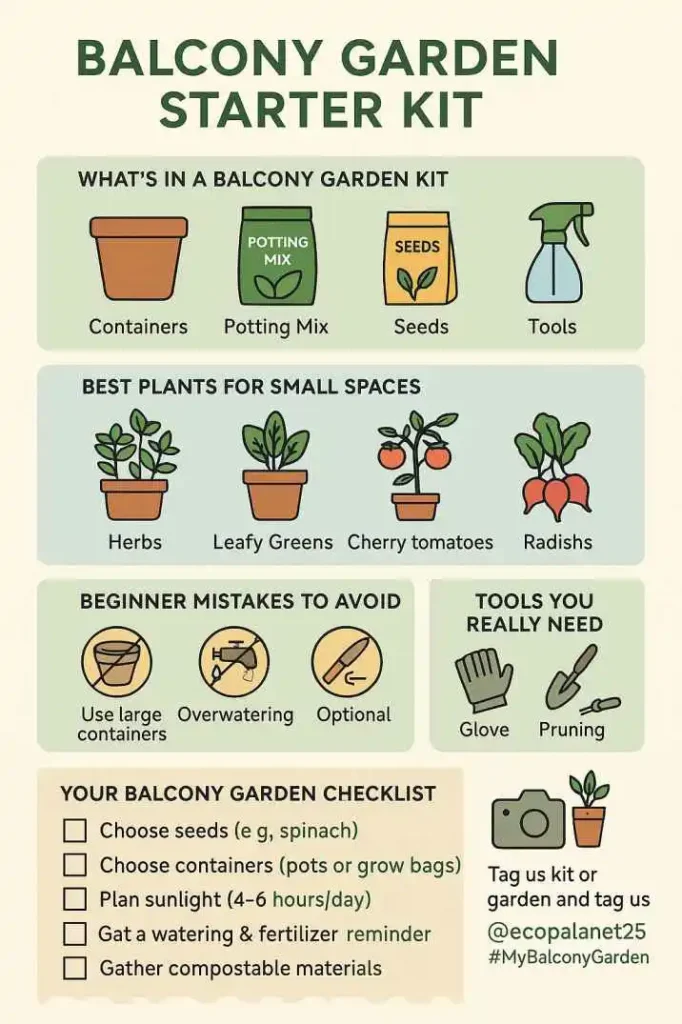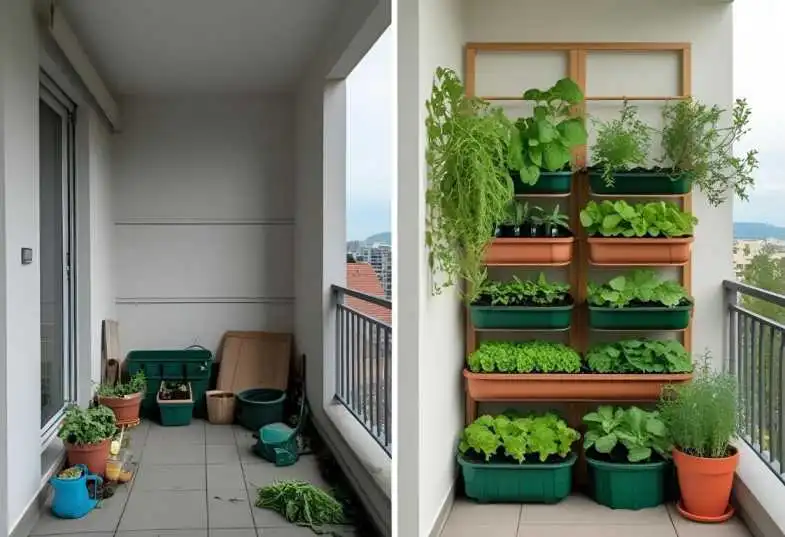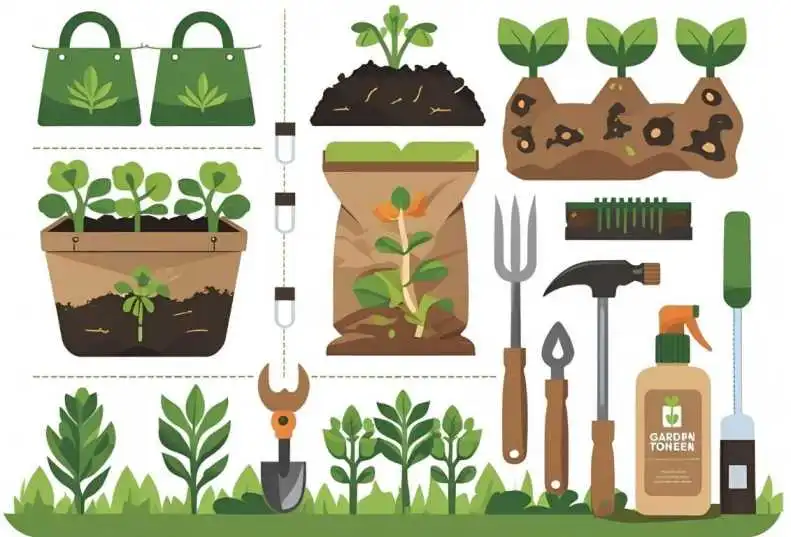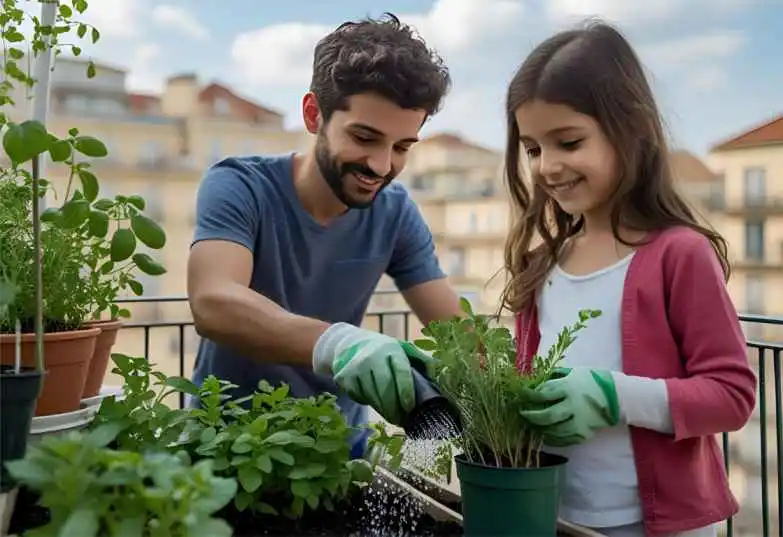Introduction
Dreaming of growing your vegetables but short on space? A balcony vegetable garden kit might be exactly what you need. Whether you live in a high-rise apartment or a compact city flat, these all-in-one kits make urban gardening simple, accessible, and incredibly rewarding.
Designed specifically for small spaces, a balcony vegetable garden kit takes the guesswork out of gardening. With curated tools, organic seeds, compact containers, and easy-to-follow instructions, even beginners can start growing fresh herbs, tomatoes, chilies, and leafy greens—right from their balcony.
In this guide, you’ll learn everything about choosing the best vegetable garden kit for your balcony, what’s typically included, how to customize your DIY version, and practical tips for success. Whether you’re starting a small kitchen garden or gifting a kit to a friend, this post will help you make a green and delicious start. Learn how to build a zero-waste kitchen garden from scratch.
🌱 Start Your Balcony Garden Today!
Get the FREE Balcony Garden Starter Kit
✅ Easy infographic
✅ Quick-start checklist
✅ Fun beginner quiz
📸 Share your balcony pics with #MyBalconyGarden and tag @ecoplanet25 to get featured!

Table of Contents
Why Use a Balcony Garden Kit?
A balcony vegetable garden kit is more than just a box of gardening tools—it’s a complete starter solution for growing food in small urban spaces. For people living in apartments or flats without access to backyards, these kits offer the perfect entry point into sustainable, home-based gardening.

Convenience for Urban Dwellers
One of the biggest advantages of a balcony vegetable garden kit is convenience. You don’t have to be a gardening expert or spend time figuring out what tools and seeds you need. Everything is included in one box—planters, soil mix, seeds, tools, and sometimes even a growing guide.
For busy urban professionals, students, or eco-conscious beginners, this plug-and-play format removes the confusion and helps you get started immediately. Kits are designed to fit easily into balcony corners, railings, or even vertical stands. You can grow basil, spinach, green chilies, or cherry tomatoes with little effort and maximum freshness.
🌿 Gardening Tip:
“Start with fast-growing leafy greens like spinach, methi, and coriander. These thrive in small containers and are ideal for balcony conditions.”
Whether you’re in Mumbai, London, or New York, this kit turns your balcony into a productive green space.
📊 Did You Know?
Over 1.3 billion tonnes of food are wasted globally each year—almost 30% of all food produced. Home gardening reduces household food waste by letting you grow only what you need.
Source: FAO – Food and Agriculture Organization
Learn more about urban gardening techniques and space-saving ideas. Urban Gardening 101 – Gardening Know How
Saves Time and Space
Urban life often means managing limited time and even more restricted space. A balcony vegetable garden kit is designed with both these constraints in mind. You won’t need to hunt for large pots or calculate the right soil mix ratios—everything is portioned, lightweight, and balcony-ready.
The compact containers ensure that even a 3×3-foot space can be transformed into a mini vegetable patch. Plus, with labeled seed packets and pre-measured nutrients, you save time on planning and maintenance.
🪴 Container Tip:
“Use stackable containers or hanging grow bags to save space. Perfect for railings or corners of small balconies.”
This space-saving, time-efficient solution makes sustainable living more accessible, especially for those new to gardening. You get the satisfaction of harvesting home-grown vegetables without worrying about setup or technical know-how.

What’s Inside a Good Balcony Vegetable Garden Kit?
If you’re wondering what makes a balcony vegetable garden kit beginner-friendly and effective, the answer lies in what’s inside the box. A well-curated kit combines simplicity, functionality, and sustainability, ensuring a smooth gardening experience from day one.
Essential Items You Should Expect
A quality balcony vegetable garden kit typically includes all the basic tools and materials needed to grow vegetables in a small outdoor space. Here’s what you can usually expect:
- Planters or grow bags: Often lightweight and designed for balconies, these containers are ideal for promoting root development and ensuring adequate drainage.
- Organic potting mix: A balanced soil mix that supports healthy root growth, moisture retention, and nutrient supply.
- Vegetable seeds: Common starter seeds include tomatoes, spinach, fenugreek (methi), mint, coriander, and green chilies.
- Basic tools include a small trowel, gloves, and a spray bottle for watering, making maintenance easier.
- Instruction booklet or growing guide: Ideal for beginners, these guides provide step-by-step instructions for planting and care.
🧤 DIY Hack:
“Don’t have gloves or tools? Use an old kitchen spoon and a cloth napkin as quick substitutes to get started.”
These components help eliminate guesswork, making it easier to start growing your food, even if you’ve never gardened before.
Extras That Add Value
Some premium or specialized balcony vegetable garden kits come with added features to enhance your gardening experience. These extras aren’t mandatory, but they do provide more convenience and better results:
- Biodegradable seed labels: Help you keep track of what you’ve planted.
- Natural pest control: Neem oil sprays or organic pesticides are often used to protect your plants without the use of chemicals.
- Watering schedule or calendar: Keeps you on track, especially useful for beginners who may over- or under-water.
- Fertilizer pouches: Small, slow-release organic fertilizers that support long-term plant health.
- Vertical plant holders or railing hooks: These maximize balcony space while adding aesthetic value.
♻️ Eco Tip:
“Many kits now use biodegradable packaging or coir pots. Reuse containers and reduce plastic waste where possible.”
These thoughtful additions can make the kit more sustainable, beginner-friendly, and even gift-worthy.
How to Choose the Right Kit for Your Balcony
Not all kits are created equal. Choosing the right balcony vegetable garden kit can mean the difference between thriving plants and frustrating results. From climate to balcony size, several factors influence what kind of kit will work best for you.
Factors to Consider
Before purchasing a balcony vegetable garden kit, take a moment to evaluate your space and needs:
- Sunlight Availability: Most vegetables need 4–6 hours of direct sunlight. South- or west-facing balconies are ideal. If your space gets less sun, look for kits that include leafy greens or herbs that tolerate shade. See this sunlight requirement guide for common vegetables. 🔗 How Much Sunlight Do Vegetables Need? – Almanac
- Balcony Size & Layout: Small balconies benefit from vertical planters or railing-hanging pots. Check if the kit is designed for compact or modular setups.
- Water Access: Easy access to water is essential. If you’re on an upper floor or need to carry water manually, choose kits that include water-efficient containers and self-watering planters.
- Local Climate: Tropical and temperate zones support different vegetables. Select a kit tailored to your region’s specific growing conditions.
🌞 Sunlight Tip:
“Place pots where they get at least 4 hours of sunlight. Rotate them every few days to ensure even growth.”
Understanding these basics will help ensure that your garden thrives, not struggles.
Best Kits for Different Needs
There’s no one-size-fits-all balcony vegetable garden kit—and that’s a good thing! Different kits suit different goals and lifestyles:
- Beginner Kits: These usually come with easy-to-grow plants like spinach, coriander, or mint. They include step-by-step instructions, making them ideal for first-timers. Start with easy herbs like basil—here’s how to grow them successfully. 🔗 Basil and Herb Growing Tips – Bonnie Plants
- Budget Kits: Look for DIY-style kits that include fewer extras but cover the basics—seeds, soil, and grow bags. Perfect for students or budget-conscious gardeners.
- Premium Kits: These kits often feature organic certification, designer pots, smart irrigation tools, and eco-friendly packaging. Great as gifts or for lifestyle upgrades.
- DIY Kits: Some prefer buying components separately. But several brands offer customizable garden kits, allowing you to pick exactly what you want.
Your ideal kit will align with your available space, skill level, and how much time you want to invest in plant care.
Personal Experience Block
🪴 My Mini Balcony Garden Story
I began my balcony gardening journey in a tiny 3×3 ft space with just 3 containers. I wasn’t sure where to start—until I tried a basic kit like the one in this guide. Within a few weeks, I was harvesting fresh methi and tomatoes. Even my daughter started enjoying it!
Here’s a photo of how my setup looks now:

DIY Balcony Vegetable Kit: What to Include
Don’t want to buy a ready-made balcony vegetable garden kit? No problem—you can easily build your version at home. A DIY kit allows you to personalize your gardening experience while keeping it budget-friendly and sustainable.
Assembling Your Own Kit Step-by-Step
Creating your own balcony vegetable garden kit is simple if you know what to include. Here’s a basic checklist to get you started:
- Containers: Reuse old buckets, terracotta pots, or plastic crates with drainage holes. Grow bags are lightweight and ideal for balconies.
- Soil mix: Combine cocopeat, compost, and garden soil in equal parts for a balanced potting mix.
- Seeds: Start with beginner-friendly vegetables like methi, spinach, radish, tomatoes, or basil. Choose organic or heirloom seeds if possible.
- Basic tools: A small hand trowel, gloves, and a spray bottle for misting plants.
- Labels: You can make your own with popsicle sticks or paper tags to track what’s planted.
- Fertilizer: Organic compost, vermicompost, or liquid fertilizer like compost tea.
With just these items, you can grow a productive garden on a modest balcony.
💡 Sustainable Tip:
A recent Indian nutrition study shows that home gardens can improve household nutrition and cut monthly grocery bills by 20–25%, especially in urban homes with limited access to fresh greens.
Budget-Friendly Tips
One of the perks of a DIY balcony vegetable garden kit is how affordable it can be. You can save money and reduce waste with a few creative hacks:
- Upcycle Containers: Old milk cans, paint buckets, or even broken kitchenware can serve as planters. Just make sure they have drainage.
- Free Compost: Use kitchen waste like vegetable peels, tea leaves, and eggshells to make your compost. Learn how to compost your kitchen waste at home with this beginner-friendly guide. 🔗 DIY Composting Basics – NRDC
- Seed Swaps: Join local gardening groups or online communities to exchange seeds for free.
- Tool Alternatives: A spoon can work as a trowel, and old gloves can protect your hands just fine.
🌱 Budget Tip:
“Try local gardening groups on Facebook or WhatsApp to swap seeds and tools. It’s a great way to garden sustainably on a budget.”
Building your kit also gives you more control over the materials you use—ideal for eco-conscious gardeners who want to reduce plastic and packaging waste.
Read our dos and don’ts of sustainable balcony gardening.
💬 Real Balcony Gardeners Say
🧑🍳 “I never thought I could grow spinach and tomatoes on my tiny 3rd-floor balcony. The kit made it so easy—and my kids love helping too!”
— Ananya M., Pune
🌿 “This starter kit helped me reduce my grocery waste and start composting. It’s now my Sunday ritual.”
— Rohan D., Bengaluru
Final Tips for Balcony Gardening Success
Whether you’ve chosen a ready-made balcony vegetable garden kit or built your DIY version, success depends on daily care and a little know-how. Here are a few final tips to help you grow healthy, thriving plants on your balcony.
Care and Maintenance Basics
Daily attention is key to keeping your balcony garden vibrant. Here’s how to stay on track:
- Watering: Most vegetables prefer moist (not soggy) soil. Water early in the morning or late in the afternoon to reduce evaporation. Use a spray bottle or watering can with a narrow spout to control flow. Discover how drip irrigation can save water and improve plant health on balconies. 🔗 Drip Irrigation for Small Gardens – Gardening Channel
- Sunlight: Make sure your plants get at least 4–6 hours of sunlight. If your balcony is shaded, stick to leafy greens like lettuce, spinach, or coriander.
- Feeding: Use organic fertilizer once every 10–15 days. Kits often include small nutrient packs—don’t overuse them.
- Pruning: Trim yellowing leaves and pinch off flower buds (for leafy greens) to encourage better growth.
💧 Watering Reminder:
“Use a spray bottle for misting seedlings. It’s gentler than pouring water and helps avoid washing away seeds.”
These simple steps will help your balcony vegetable garden kit yield fresh produce all season long.
🌟 Community Voices
“I used the DIY checklist to build my kit and now have coriander, mint, and cherry tomatoes growing on my balcony. Never felt more connected to nature!”
— Priya S., Chennai
“Even with zero gardening experience, I felt confident after reading this guide. My balcony is my new favorite corner!”
— Jay R., Delhi
Beginner Mistakes to Avoid
Starting small is smart, but avoiding these common mistakes will save you frustration and boost your confidence:
- Overwatering: Too much water can lead to root rot. Always check the topsoil with your finger before watering.
- Overcrowding: Planting too many seeds in a single pot can stunt growth. Follow spacing instructions.
- Ignoring Drainage: Containers without holes will lead to soggy roots. Always check the drainage before planting.
- Not Labeling Plants: It’s easy to forget what you’ve planted where. Use labels, especially if you’re growing similar-looking greens.
By staying consistent and avoiding these pitfalls, even first-time gardeners can enjoy fresh herbs and vegetables grown from their own balcony vegetable garden kit.
🌍 Eco Insight:
Perishable items like spinach, mint, and coriander often spoil before use—home-grown versions help reduce food waste by up to 50%, according to the NRDC.
Source: National Resource Defense Council (NRDC)
Conclusion
Starting your vegetable garden doesn’t require a big backyard or professional tools—just a little balcony, some sunlight, and the right kit. Whether you choose a ready-made balcony vegetable garden kit or create your DIY version, the joy of growing your food is truly unmatched.
With the right tools, a few easy-care vegetables, and simple daily maintenance, even first-time gardeners can succeed. These kits remove the guesswork, making gardening less intimidating and more accessible, especially in urban homes where space is at a premium.
📦 Impact Bonus:
Even a small 1-square-meter garden can yield up to 20 kg of fresh vegetables per season—saving money, cutting waste, and promoting healthier eating.
Source: RUAF Urban Agriculture Study
From the convenience they offer to the sustainable lifestyle they promote, balcony gardening kits are a smart investment in your health and the planet. So why wait? Get started today, and turn your balcony into a mini green paradise.
🌱 Want more green living inspiration? Explore our related articles, subscribe to our newsletter, or share your balcony garden journey in the comments below. We’d love to hear how your plants grow!
Download the Balcony Garden Starter Kit [Infographic + Quiz PDF]
Frequently Asked Questions (FAQs)
What is a Balcony Vegetable Garden Kit?
A Balcony Vegetable Garden Kit is an all-in-one package designed for urban gardeners with limited space. It typically includes containers or grow bags, potting soil, vegetable seeds, basic tools (like a trowel and spray bottle), and care instructions, making it easy to start growing fresh produce on a balcony.
What are the benefits of using a Balcony Vegetable Garden Kit?
Kits provide convenience and reduce confusion. They save time and space by offering pre-portioned soil, containers, and labels—ideal for beginners in cities looking to maximize small spaces efficiently.
What items should come in a quality Balcony Vegetable Garden Kit?
Expect essentials like planters (fabric grow bags or lightweight pots), organic potting mix, beginner-friendly veggie seeds (e.g., basil, spinach, tomatoes), and small tools. Premium kits may include extra items like pest spray, plant markers, and vertical supports.
How much sunlight does a Balcony Vegetable Garden Kit need?
Most kits perform best with 4–6 hours of direct sunlight daily. Herbs and greens can tolerate partial shade, while fruiting vegetables like tomatoes require fuller sun.
What vegetables grow best in a Balcony Vegetable Garden Kit?
Beginner-friendly options include mint, basil, spinach, coriander, salad greens, and cherry tomatoes. These are low-maintenance and well-suited to container gardening. View this expert list of container-friendly vegetables. 🔗 Best Vegetables to Grow in Containers – RHS UK
How often should I water my Balcony Vegetable Garden Kit?
Water early in the morning or at dusk. Container gardens often need daily watering, less so in cooler months. Using self-watering pots or drip systems helps maintain consistent moisture.
What common mistakes do people make with the Balcony Vegetable Garden Kit?
Be careful not to overwater, overcrowd plants, or ignore proper drainage. Ensure containers have holes and avoid squeezing too many plants into a small pot—these are common issues.
Can I build a DIY Balcony Vegetable Garden Kit?
Yes! You can assemble your own by upcycling containers, mixing soil with compost, picking suitable seeds, and adding simple tools and labels. This approach is budget-friendly and sustainable.
Is a Balcony Vegetable Garden Kit expensive to start?
Not necessarily. Kits vary in cost: budget-friendly kits focus on basics, while premium options include extras like irrigation systems and designer planters. DIY versions offer the most cost-efficient route.
Does my balcony need structural support for a Balcony Vegetable Garden Kit?
Yes. Moist soil and containers can be heavy. Check weight limits in your building and use lightweight pots (plastic, fabric, or composite). Ensure drainage water doesn’t leak downstairs.
Can I grow tomatoes in shade?
Tomatoes need at least 5–6 hours of direct sunlight daily for healthy growth and fruit production. While partial shade may allow the plant to grow, it will likely result in reduced yield and smaller fruits. For shaded balconies, consider leafy greens like spinach, lettuce, or herbs like mint and coriander instead.
How often should I water the kit?
Watering frequency depends on the season, plant type, and pot size. As a general rule:
In summer: Once daily or twice if the soil dries quickly
In winter: Every 2–3 days
Always check if the top inch of soil feels dry before watering.
Want to learn more about Balcony Garden?
- The Ultimate Guide to Creating a Thriving Balcony Garden
- The Complete Guide to Balcony Vegetables for Beginners
- DIY Balcony Vegetable Garden Ideas will be coming to our site soon!
About the Author
Soumen Chakraborty is an environmental writer and eco-living advocate who helps Indian households start sustainable journeys. He’s the founder of greenglobe25.in and writes beginner-friendly guides on zero-waste living, balcony gardening, and eco products.
🪴 Follow on Facebook: ecoplanet25
Loved these Balcony garden tips?
Share this with your friends on Facebook, use #MyBalconyGarden, Pinterest, or Twitter, and spread the green!
Disclosure: As an Amazon Associate, I earn from qualifying purchases at no extra cost to you. Your support helps keep this site running. Thank you!

